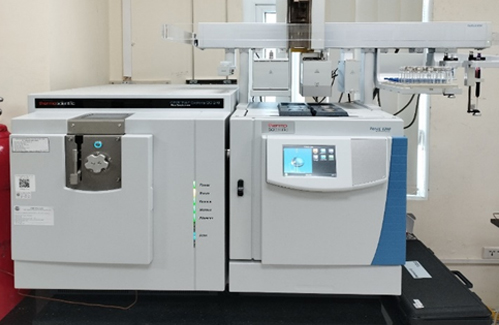- Folder Chemical field
- Views 880
- Last Updated 15/10/2024
1. Structure of the Orbitrap Exploris GC 240
The Orbitrap Exploris GC 240 consists of three main components: The gas chromatography (GC) system, the ionization source, and the Orbitrap mass analyzer (Figure 1).
- Gas Chromatography System (GC): The GC plays a role in separating substances in the sample based on their volatility and interaction with the chromatography column. Substances are introduced via the sample injector and move through the column with the help of helium carrier gas. Different substances exit the column at different times, allowing their separation before entering the ionization source.
- Ionization Source: After separation in the GC, the substances are transferred to the ionization source, where they are converted into positive or negative ions. Common ionization methods include Chemical Ionization (CI) and Electron Ionization (EI).
Orbitrap Mass Analyzer: After ionization, the ions are sent into the Orbitrap mass analyzer. This analyzer is the core of the system, where the measurement and high-precision mass analysis take place.

Figure 1: GC-HRMS Orbitrap Exploris GC 240 system at the National Institute for Food Control
2. Operating Principle of the Orbitrap
The operating principle of the Orbitrap analyzer is based on measuring the oscillation frequencies of ions in a non-uniform electrostatic field, created by a central spindle-shaped electrode and a surrounding ring electrode. When ions enter the Orbitrap analyzer, they are trapped in the electrostatic field and oscillate along characteristic trajectories depending on their mass and charge.
3. Advantages of the Orbitrap Exploris GC 240
- High Resolution: The Orbitrap Exploris GC 240 offers a resolution of up to 240,000 FWHM, enabling the differentiation of ions with very close masses in complex sample matrices.
- High Sensitivity: Its ability to accurately measure compounds even at very low concentrations makes it suitable for applications requiring high sensitivity, such as trace analysis of banned substances in food or pharmaceuticals.
- High Selectivity: The Orbitrap Exploris GC 240 has high selectivity (< 5 ppm), allowing precise identification of analytes.
4. Applications of the Orbitrap Exploris GC 240 at the National Institute for Food Control
The GC-HRMS Orbitrap Exploris GC 240 is currently being used at the National Institute for Food Control for:
- Detecting unknown compounds, especially in determining the cause of food poisoning;
- Product traceability; distinguishing between real and counterfeit or mixed food products;
- Analyzing pesticide residues and insecticides;
- Analyzing PCBs and emerging contaminants;
- Analyzing food additives;
- Analyzing volatile compounds.









-cua-hang-Waters.jpg)









